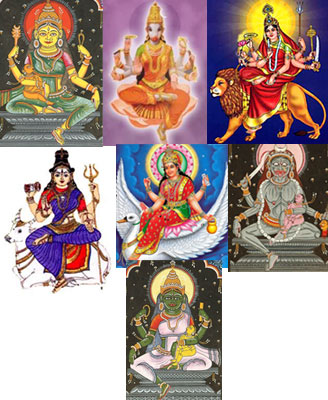 Sapta Matrika or Seven Mother goddesses are identified with human vice, aggression, and disease. The seven Goddesses are classified according to a system. In this system every goddess is linked to a male equivalent, has her own creature to travel and represents a particular human fault. The seven Goddesses include Brahmani, Vaishnavi, Maheshvari, Indrani, Varahi, Kaumari and Chamunda. Seven Matrikas play an important role in Hinduism, Shaktism and Tantrism. They are also linked to Lord Skanda who is worshipped as warrior God. However in early texts they are considered to possess inauspicious qualities. Therefore they symbolize the fruitful and destructive aspects of nature.
Sapta Matrika or Seven Mother goddesses are identified with human vice, aggression, and disease. The seven Goddesses are classified according to a system. In this system every goddess is linked to a male equivalent, has her own creature to travel and represents a particular human fault. The seven Goddesses include Brahmani, Vaishnavi, Maheshvari, Indrani, Varahi, Kaumari and Chamunda. Seven Matrikas play an important role in Hinduism, Shaktism and Tantrism. They are also linked to Lord Skanda who is worshipped as warrior God. However in early texts they are considered to possess inauspicious qualities. Therefore they symbolize the fruitful and destructive aspects of nature.
The Sapta Matrikas are described below:
Brahmani
She is the symbol of pride. She is linked to Lord Brahma, and her vehicle is a goose. She has four hands. Her features are the watering container and prayer beads. She is differentiated by her basket-shaped crown called Karanda Mukuta.
Vaishnavi
She represents greed. She is linked to Lord Vishnu. She travels on an eagle and has four or six hands. Wheel and conch shell are her attributes. She is also possess a cylindrical crown called kirita Mukuta
Maheshvari
She symbolizes greed. She is linked to Lord Shiva and travels on a bull. She has three eyes, four, six, or ten hands. Her attributes are prayer beads and a spear.
Indrani
Indrani represents fury. She is linked to Lord Indra who rides on an elephant. She has four hands and her attributes are a spear and bolt of lightning.
Varahi
Varahi characterize lust. She is linked to Varaha, incarnation of Lord Vishnu. She rides on a bull. She has four hands and her attributes are a plough and a spear.
Kaumari
Kaumari represents bad temper. She is associated with Lord Skanda and rides on a peacock. She has three eyes and two or four or twelve arms. Her attributes are a cockerel and a spear.
Chamunda
She represents loss of sight. She is associated with Lord Yama and rides on an owl or on a corpse. Her attributes are a skull bowl, spear, sword, shield and battle axe.
They became popular by the seventh century and by the ninth century they were being worshipped in temples.




















